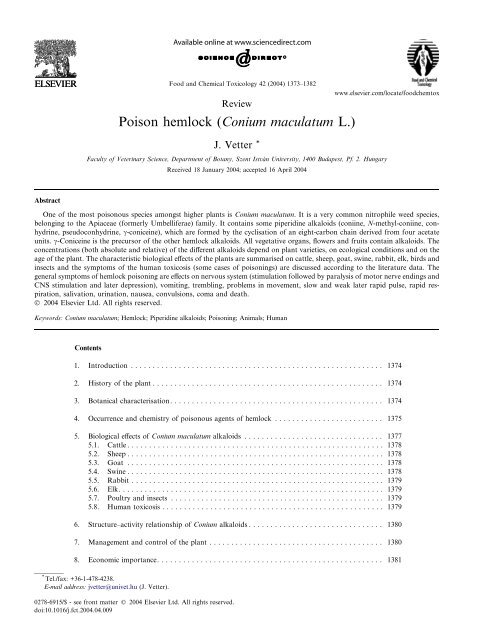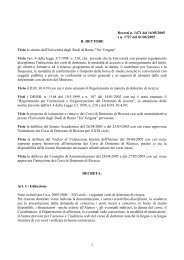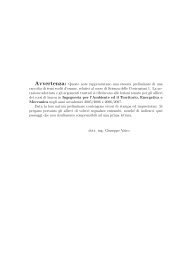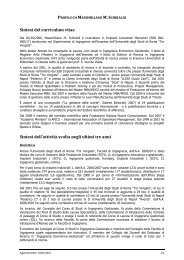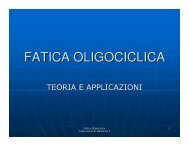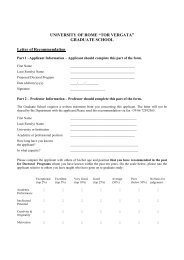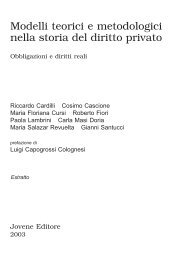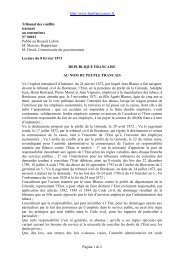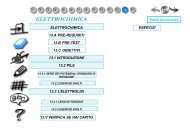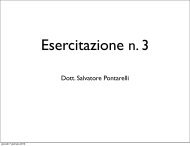Create successful ePaper yourself
Turn your PDF publications into a flip-book with our unique Google optimized e-Paper software.
Abstract<br />
Review<br />
<strong>Poison</strong> <strong>hemlock</strong> (<strong>Conium</strong> <strong>maculatum</strong> L.)<br />
J. Vetter *<br />
Faculty of Veterinary Science, Department of Botany, Szent Istvan University, 1400 Budapest, Pf. 2. Hungary<br />
Received 18 January 2004; accepted 16 April 2004<br />
One of the most poisonous species amongst higher plants is <strong>Conium</strong> <strong>maculatum</strong>. It is a very common nitrophile weed species,<br />
belonging to the Apiaceae (formerly Umbelliferae) family. It contains some piperidine alkaloids (coniine, N-methyl-coniine, conhydrine,<br />
pseudoconhydrine, c-coniceine), which are formed by the cyclisation of an eight-carbon chain derived from four acetate<br />
units. c-Coniceine is the precursor of the other <strong>hemlock</strong> alkaloids. All vegetative organs, flowers and fruits contain alkaloids. The<br />
concentrations (both absolute and relative) of the different alkaloids depend on plant varieties, on ecological conditions and on the<br />
age of the plant. The characteristic biological effects of the plants are summarised on cattle, sheep, goat, swine, rabbit, elk, birds and<br />
insects and the symptoms of the human toxicosis (some cases of poisonings) are discussed according to the literature data. The<br />
general symptoms of <strong>hemlock</strong> poisoning are effects on nervous system (stimulation followed by paralysis of motor nerve endings and<br />
CNS stimulation and later depression), vomiting, trembling, problems in movement, slow and weak later rapid pulse, rapid respiration,<br />
salivation, urination, nausea, convulsions, coma and death.<br />
Ó 2004 Elsevier Ltd. All rights reserved.<br />
Keywords: <strong>Conium</strong> <strong>maculatum</strong>; Hemlock; Piperidine alkaloids; <strong>Poison</strong>ing; Animals; Human<br />
Contents<br />
1. Introduction . . . . . . . . . . . . . . . . . . . . . . . . . . . . . . . . . . . . . . . . . . . . . . . . . . . . . . . . . . 1374<br />
2. History of the plant . . . . . . . . . . . . . . . . . . . . . . . . . . . . . . . . . . . . . . . . . . . . . . . . . . . . . 1374<br />
3. Botanical characterisation. . . . . . . . . . . . . . . . . . . . . . . . . . . . . . . . . . . . . . . . . . . . . . . . . 1374<br />
4. Occurrence and chemistry of poisonous agents of <strong>hemlock</strong> . . . . . . . . . . . . . . . . . . . . . . . . . 1375<br />
5. Biological effects of <strong>Conium</strong> <strong>maculatum</strong> alkaloids . . . . . . . . . . . . . . . . . . . . . . . . . . . . . . . . 1377<br />
5.1. Cattle . . . . . . . . . . . . . . . . . . . . . . . . . . . . . . . . . . . . . . . . . . . . . . . . . . . . . . . . . . . 1378<br />
5.2. Sheep . . . . . . . . . . . . . . . . . . . . . . . . . . . . . . . . . . . . . . . . . . . . . . . . . . . . . . . . . . . 1378<br />
5.3. Goat . . . . . . . . . . . . . . . . . . . . . . . . . . . . . . . . . . . . . . . . . . . . . . . . . . . . . . . . . . . 1378<br />
5.4. Swine . . . . . . . . . . . . . . . . . . . . . . . . . . . . . . . . . . . . . . . . . . . . . . . . . . . . . . . . . . . 1378<br />
5.5. Rabbit . . . . . . . . . . . . . . . . . . . . . . . . . . . . . . . . . . . . . . . . . . . . . . . . . . . . . . . . . . 1379<br />
5.6. Elk. . . . . . . . . . . . . . . . . . . . . . . . . . . . . . . . . . . . . . . . . . . . . . . . . . . . . . . . . . . . . 1379<br />
5.7. Poultry and insects . . . . . . . . . . . . . . . . . . . . . . . . . . . . . . . . . . . . . . . . . . . . . . . . . 1379<br />
5.8. Human toxicosis . . . . . . . . . . . . . . . . . . . . . . . . . . . . . . . . . . . . . . . . . . . . . . . . . . . 1379<br />
6. Structure–activity relationship of <strong>Conium</strong> alkaloids . . . . . . . . . . . . . . . . . . . . . . . . . . . . . . . 1380<br />
7. Management and control of the plant . . . . . . . . . . . . . . . . . . . . . . . . . . . . . . . . . . . . . . . . 1380<br />
8. Economic importance. . . . . . . . . . . . . . . . . . . . . . . . . . . . . . . . . . . . . . . . . . . . . . . . . . . . 1381<br />
* Tel./fax: +36-1-478-4238.<br />
E-mail address: jvetter@univet.hu (J. Vetter).<br />
0278-6915/$ - see front matter Ó 2004 Elsevier Ltd. All rights reserved.<br />
doi:10.1016/j.fct.2004.04.009<br />
Food and Chemical Toxicology 42 (2004) 1373–1382<br />
www.elsevier.com/locate/foodchemtox
1374 J. Vetter / Food and Chemical Toxicology 42 (2004) 1373–1382<br />
1. Introduction<br />
9. Conclusions. . . . . . . . . . . . . . . . . . . . . . . . . . . . . . . . . . . . . . . . . . . . . . . . . . . . . . . . . . . 1381<br />
References . . . . . . . . . . . . . . . . . . . . . . . . . . . . . . . . . . . . . . . . . . . . . . . . . . . . . . . . . . . . . . . 1381<br />
The plant species <strong>Conium</strong> <strong>maculatum</strong> (<strong>hemlock</strong>, poisonous<br />
<strong>hemlock</strong>) is one of the most toxic members of the<br />
plant kingdom. There are numerous reports of deaths<br />
for a wide range of animal species including humans.<br />
<strong>Conium</strong> <strong>maculatum</strong> has a worldwide distribution; it is a<br />
very common plant species, a member of the family<br />
Apiaceae (formerly Umbelliferae), the carrot family.<br />
This review summarises the botanical, chemical and<br />
toxicological aspects of this plant.<br />
2. History of the plant<br />
The juice or the extract of <strong>Conium</strong> <strong>maculatum</strong> was<br />
allegedly administered to criminals, and was the lethal<br />
poison, which the Greek philosopher Socrates was<br />
condemned to drink (399 BC). The symptoms of poisoning<br />
were described by Plato (a pupil of Socrates).<br />
The old Roman name of the plant was Cicuta, but this<br />
name was later applied (by Gesner, 1541) to another<br />
umbelliferous plant, Cicuta virosa (water <strong>hemlock</strong>). The<br />
consequent confusion was solved by the nomenclature<br />
of Linnaeus, who restored the classical Greek name<br />
describing the plant as <strong>Conium</strong> <strong>maculatum</strong>. The generic<br />
name was derived from the Greek word Konas, meaning<br />
to whirl about, because the consumption of the plant<br />
causes ataxia, tremor and convulsions. The specific<br />
name (<strong>maculatum</strong>) is a Latin word, meaning spotted and<br />
refers to the very characteristic brownish–reddish spots<br />
of stem.<br />
The plant was used in ancient Anglo-Saxon medicine;<br />
and the English name––<strong>hemlock</strong>––is derived from the<br />
Anglo-Saxon words hemlic or hymelic. Through the<br />
centuries, spelling and pronunciation have taken many<br />
forms, ranging from hymlice to hymlic, hemeluc, hemlake,<br />
<strong>hemlock</strong>e, and finally <strong>hemlock</strong>. William Shakespeare,<br />
in ‘‘Life of Henry the Fifth’’, first used the<br />
modern spelling <strong>hemlock</strong> (Simpson and Weiner, 1989).<br />
<strong>Conium</strong> <strong>maculatum</strong> was employed externally to treat<br />
herpes, erysipelas (a form of superficial cellulites) and<br />
breast tumours. More recently, unripe <strong>Conium</strong> seeds<br />
were, dried and stored to be used as an antispasmodic, a<br />
sedative or an analgesic. The dried leaf and juice of the<br />
plant were listed in pharmacopoeias of London and<br />
Edinburgh from 1864 to 1898 and the last official<br />
medicinal recognition appeared in the British Pharmaceutical<br />
Codex of 1934 in Great Britain (Bowman and<br />
Snaghvi, 1963).<br />
The medicinal importance of <strong>hemlock</strong> is very limited<br />
because of the closeness between therapeutic and poisonous<br />
levels (Holm, 1997). Both Greek and Arabian<br />
physicians were in the practice of using it for the cure of<br />
indolent tumours, swellings and pains of the joins. The<br />
bitter juice of the plant was mixed with betony (Stachys<br />
officinalis) and fennel (Foeniculum vulgare) seeds for the<br />
bite of a mad dog. Later in history, this juice was<br />
administered as a last resort, as an antidote for strychnine<br />
and other strongly poisonous compounds (Le<br />
Stragne, 1977). Religious sects of the 15th and 16th<br />
centuries used the roasted roots for relieving the pains<br />
of gout. In the 1760s, it began to be used as a cure<br />
for cancerous ulcers. The US imported annually<br />
(prior to World War I) about 14,000 kg seeds and 7000<br />
kg of dried leaves as a drug. The tinctures and extracts<br />
of the plants were used because of their sedative, anodyne<br />
and antispasmodic effects (in the cases of asthma,<br />
epilepsy, whooping cough, angina, chorea, stomach<br />
pains). The drug has to be administrated with care,<br />
as narcotic poisoning may result from internal use,<br />
overdoses producing paralysis. There are contra-dictionary<br />
opinions about the possibility of care use of <strong>hemlock</strong><br />
in the medicine. Hemlock remains a classic<br />
homeopathic agent with various uses (Zdanevich and<br />
Belodubrovskaya, 1997). Said to be a long-acting<br />
remedy, it is of special value in old age when the vital<br />
powers of the body are failing. It has been used against a<br />
serious type of malignant tumour. The mother homeopathic<br />
tincture is prepared from the fresh flowering<br />
plant.<br />
3. Botanical characterisation<br />
<strong>Conium</strong> <strong>maculatum</strong> is a tall, branched plant with<br />
white flowers. It is a biennial plants, usually 120–180<br />
(200) cm high (Fig. 1). The root, described as a taproot,<br />
is long, forked and pale yellow. As a biennial <strong>Conium</strong><br />
<strong>maculatum</strong> produces a basal rosette in the first year, and<br />
then produces the flowering stems during the second<br />
year. The stem is erect, smooth, slightly ridged, stout<br />
below, much branched above and hollow, and is bright<br />
green. It is distinctively mottled with small irregular
Fig. 1. <strong>Poison</strong> <strong>hemlock</strong> (<strong>Conium</strong> <strong>maculatum</strong> L.).<br />
purple spots. The leaves are numerous, alternate, longstalked,<br />
tripinnate (i.e. divided along the midrib into<br />
opposite pairs of leaflets and these again divided and<br />
subdivided). The upper leaves are much smaller, sometimes<br />
nearly stalkless, dipinnate or pinnate, quite<br />
smooth. The umbels are small, numerous, have a terminal<br />
position, with 12–16 rays to the umbel. At the<br />
base of the main umbel one can see 4–8 lance-shaped<br />
bracts. The petals of the small flowers are white with an<br />
inflexed point. The stamens of the flowers are longer<br />
than the petals and have white anthers. The inflorescence<br />
is produced mainly from June to September. The<br />
fruit is a broadly ovoid, double achene (it is a schizocarp),<br />
and is composed of two greyish-brown seeds with<br />
five wavy, longitudinal ridges. At germination the cotyledons<br />
are narrow and lanceolate, the first true leaves<br />
have two or more leaflets along an axis and are hairless.<br />
The plant has a bitter taste and a mousy odour. Where<br />
plants are numerous, the odour can be very pervasive.<br />
The seeds or fruits do not a have very marked odour,<br />
but if crushed or mixed with an alkali as potassium<br />
hydroxide solution, the same characteristic, odour of<br />
mouse urine is produced.<br />
<strong>Conium</strong> <strong>maculatum</strong> resembles water <strong>hemlock</strong> (Cicuta<br />
virosa). The two plants, however, may be distinguished<br />
on the basis of characteristic morphological<br />
properties:<br />
J. Vetter / Food and Chemical Toxicology 42 (2004) 1373–1382 1375<br />
<strong>Conium</strong> <strong>maculatum</strong> Cicuta virosa<br />
Single taproot Branched root system,<br />
with a lateral tuber<br />
Purple spotted stem Absence of such spots<br />
Mousy odour Absence of the odour<br />
<strong>Conium</strong> <strong>maculatum</strong> damp ground, hedgerows, banks<br />
of streams and rivers, roadsides and woodland, pastures,<br />
meadows, and waste ground. The plant is reported as a<br />
very common weed in Europe, North and South<br />
America, North Africa, Australia and New Zealand,<br />
and there are data about its occurrence in Ethiopia<br />
(Mekkonen, 1994), and in Pakistan (Ahmed et al.,<br />
1989). It was brought to the United States from Europe<br />
as a garden plant. In other countries the presence of the<br />
plant is a consequence of the transport of grain, for<br />
example in Norway (Kielland and Anders, 1998). In<br />
Hungary, the plant is one of the commonest weeds and<br />
poisonous plants (Vetter, 1999), with cases of poisonings<br />
occurring mainly in the spring or summer. <strong>Conium</strong><br />
<strong>maculatum</strong> prefers moist soils with high nitrogen level<br />
(i.e. it is a nitrophile plant). A single plant may produce<br />
about 35,000–40,000 seeds, which usually fall near the<br />
parent plant but can be spread by water and animals<br />
(Mitich, 1998). <strong>Conium</strong> <strong>maculatum</strong> belongs to a group of<br />
very common, wide spreaded weed species; therefore its<br />
germination (mainly the ecological conditions) is an<br />
important target of investigations. In north-central<br />
Kentucky (USA) seeds of <strong>Conium</strong> <strong>maculatum</strong> are dispersed<br />
from mid-September to mid-February. Studies<br />
showed (Baskin and Baskin, 1990), that 40–85% of the<br />
freshly matured seeds had morphological dormancy<br />
(needing only a moist substrate, a photoperiod of 14 h<br />
light and alternating thermoperiods of 30/15 °C) for<br />
normal germination. <strong>Conium</strong> <strong>maculatum</strong> can be a tenacious<br />
weed species particularly in moist habitats. It may<br />
act as a pioneer species quickly colonizing disturbed<br />
sites.<br />
4. Occurrence and chemistry of poisonous agents of<br />
<strong>hemlock</strong><br />
<strong>Conium</strong> <strong>maculatum</strong> contains piperidine alkaloids:<br />
coniine (2-propylpiperidine), N-methyl-coniine<br />
(1-methyl-2-propylpiperidine), conhydrine 2-(1-hydroxypropyl)-piperidine,<br />
pseudoconhydrine (5-hydroxypropyl)-piperidine<br />
(these are saturated piperidine<br />
alkaloids) and c-coniceine (2n-propyl-1D-piperidine), a<br />
partially unsaturated one (see Fig. 2). Conhydrinone<br />
and N-methyl-pseudoconhydrine were later isolated<br />
(Leete and Olson, 1972; Roberts and Brown, 1981). The<br />
piperidine alkaloids (numbering several hundred) in
1376 J. Vetter / Food and Chemical Toxicology 42 (2004) 1373–1382<br />
Fig. 2. The alkaloids of <strong>Conium</strong> <strong>maculatum</strong> (according to Lopez et al.,<br />
1999).<br />
general are derived biosynthetically from lysine, acetate<br />
or mevalonate as the precursor. The piperidine alkaloids<br />
found in <strong>Conium</strong> <strong>maculatum</strong> are acetate-derived. The<br />
results of chemical and biochemical investigations suggested,<br />
that <strong>Conium</strong> piperidine alkaloids are formed by<br />
the cyclisation of an eight-carbon chain derived from<br />
four acetate units. Nitrogen was incorporated at some<br />
stage in the pathway to give the piperidine nucleus.<br />
Experiments with N-labelled amino acids showed, that<br />
L-alanine provided the N in a transaminase catalysed<br />
enzymatic reaction (the presence of such a aminotransferase<br />
which produces c-coniceine from 5-oxooctanal,<br />
was established). After the transamination, the 5-oxooctylamine<br />
is formed, there is a non-enzymatic cyclisation<br />
producing c-coniceine (the biogenetic pathway is<br />
shown in Fig. 3). c-Coniceine is the precursor of the<br />
other <strong>Conium</strong> alkaloids. The observation, that when the<br />
concentration of coniine was higher, the concentration<br />
of c-coniceine was low, and vice versa supported the<br />
precursor role of c-coniceine in the biosynthesis of<br />
coniine.<br />
The interconversion of coniine and c-coniceine in<br />
<strong>Conium</strong> plants indicated that these compounds are<br />
members of an oxidation-reduction system. The c-coniceine<br />
was reduced to coniine by a c-coniceine reductase<br />
but the reverse reaction also occurred. The reduction of<br />
c-coniceine, however, is stochiometrically preferred. The<br />
formation of conhydrine and conhydrinone from cconiceine<br />
has been demonstrated. It was suggested<br />
(Leete and Olson, 1972) the allylic oxidation of c-coniceine<br />
gives 1 0 -hydroxy-c-coniceine. It produces the enol<br />
of conhydrinone by a tautomeric shift of the double<br />
bond, which is reduced to conhydrine. Similarly c-coniceine<br />
can function as a direct precursor to pseudoconhydrine.<br />
A mechanism for the biosynthesis of<br />
pseudoconhydrine has been proposed whereby c-coniceine<br />
undergoes a tautomeric shift of the double bond,<br />
producing an intermediate which is then oxidised at C5<br />
to a second intermediate, which is finally reduced to<br />
pseudoconhydrine (Panter and Keeler, 1989).<br />
The majority of the Apiaceae (Umbelliferae) plants<br />
produce different volatile oils in clearly delimited tissues<br />
of the fruits. It is known that <strong>Conium</strong> <strong>maculatum</strong> produces<br />
and contains piperidine alkaloids but the synthesis<br />
and accumulation sites have not yet been unequivocally<br />
identified. The location of secretory structures and the<br />
presence of essential oils and alkaloids were investigated<br />
(Corsi and Biasci, 1998). In seedlings positive histochemical<br />
reactions to alkaloids were made both in the<br />
root and the shoot tips. In more mature plants these<br />
positive reactions tended to disappear, whereas the cells<br />
of elongations’s zones reacted very positively. All vegetative<br />
organs and flowers showed strong, positive reactions<br />
at the secretory duct level. Positive reactions were<br />
shown in fruits only by secretory ducts. Ten days after<br />
fertilisation the presence of alkaloids was demonstrated<br />
in different layers of the fruit wall (in the endocarp, in<br />
the inner layer of the mesocarp and in the exocarp). The<br />
histochemical findings suggest that the secretory structures<br />
either produce alkaloid themselves or that they are<br />
supplied continuously with alkaloids from root and<br />
shoot tips. According to the earlier conclusions (for<br />
example, Cromwell, 1956) the alkaloid synthesis in<br />
<strong>Conium</strong> <strong>maculatum</strong> took place more readily in tissues of<br />
the shoot than the root. These findings (Corsi and<br />
Biasci, 1998) suggest, the <strong>Conium</strong> <strong>maculatum</strong> is similar<br />
to other members of the Apiaceae family, having<br />
secretory ducts in vegetative organs and fruits.<br />
The concentrations and the relative proportions of<br />
the different <strong>Conium</strong> alkaloids appear to depend on<br />
different factors (temperature, moisture, time and age of<br />
the plant). According to earlier experiments (Fairbairn<br />
and Challen, 1959) c-coniceine was the predominant
alkaloid component during the rainy season and coniine<br />
was predominant during the dry period. The c-coniceine<br />
content decreased, the coniine content increased markedly<br />
during the fruit ripening phase (Fairbairn and<br />
Challen, 1959). The relative concentration of the alkaloids<br />
changes with the stage of development and is<br />
varied in different plants. The seedlings contained low<br />
total alkaloid content, mainly c-coniceine (Cromwell,<br />
1956). In the leaves of the young plants (i.e. in the phase<br />
of the active growth) c-coniceine was the major alkaloid<br />
component with small amounts of conhydrine. The<br />
roots contained only traces of alkaloids, in the dormant<br />
stage however, they have higher proportion of c-coniceine<br />
and coniine than roots of the young plants with<br />
great metabolic activity. The phases of flowering, pollination<br />
and fertilisation show a sharp change in distribution<br />
of alkaloids. The coniine content increases<br />
rapidly, the amount of c-coniceine decreases. When the<br />
J. Vetter / Food and Chemical Toxicology 42 (2004) 1373–1382 1377<br />
Fig. 3. Biosynthetic pathway of c-coniceine started from acetate (according to Panter and Keeler, 1989).<br />
fruits are riped, the N-methyl-coniine is the predominant<br />
component. The concentration of coniine and c-coniceine<br />
fluctuated very rapidly during the day (diurnal<br />
changes), the increase of the first corresponds to a decrease<br />
of the second (Fairbairn and Suwal, 1961).<br />
The data on total alkaloid content in different<br />
organs of <strong>Conium</strong> <strong>maculatum</strong> has been summarised<br />
(Lopez et al., 1999), roots contain 0–0.5%, shoots 0.02–<br />
0.7%, leaves 0.3–1.5%, flowers 1.0%, unripe fruits<br />
1.6–3.0, ripe fruits 0.2–1.0% and seeds 0.02–0.9%,<br />
respectively.<br />
5. Biological effects of <strong>Conium</strong> <strong>maculatum</strong> alkaloids<br />
The consumption of varying parts of the plants<br />
(leaves, fruits) can cause different degrees of clinical effects<br />
and there appears to be different susceptibility to<br />
toxicity between species.
1378 J. Vetter / Food and Chemical Toxicology 42 (2004) 1373–1382<br />
5.1. Cattle<br />
Hemlock is more poisonous to cows than to other<br />
animals. Fresh plant collected at the same site was lethal<br />
to cows at the dosage 5.3 g plant/kg body weight (Keeler<br />
and Balls, 1978). The general symptoms of poisoning of<br />
cattle are: arthrogryposis, breathing, carpal joint, elbow<br />
joint, depression, diarrhoea, gait, incoordination, lateral<br />
rotation of limbs, muscle spasms, salivation, teeth<br />
grinding, torticollis, trembling, coffee-coloured urine,<br />
vomiting (Penny, 1953; Keeler, 1977; Cooper and<br />
Johnson, 1984). Cattle in two herds developed signs of<br />
bloating, increased salivation and lacrimation, depression,<br />
respiratory distress, ataxia and death after ingestion<br />
of hay that contained larger amount of the plant<br />
(Galey et al., 1992). The <strong>Conium</strong> alkaloids (coniine, cconiceine)<br />
were determined in the hay, the plants of the<br />
hayfield and the urine of affected animals. Congenital<br />
skeletal malformations in calves from ingestion of<br />
<strong>hemlock</strong> have been reported. Skeletal malformations<br />
were induced in calves both with fresh plants and with<br />
pure coniine (Keeler, 1977; Keeler and Balls, 1978;<br />
Keeler et al., 1980). According to the latest experiments:<br />
clinical signs of toxicity became evident about 30–40<br />
min after orally dosing. Animals first became nervous<br />
and shortly developed tremors and the animals had an<br />
ataxic gait. These signs lasted each day for 6–7 h in<br />
cows. After three to four days of administration of<br />
coniine the animals developed persistent signs of<br />
depression. Terata induced in calves included severe<br />
carpal flexure, rotation of the forelimbs elbow joint<br />
rigidity and curvature of the vertebral column. Elimination<br />
of plant toxicants via milk by lactating animals is<br />
considered a minor route of excretion, however, it may<br />
be important when the health of the neonate or food<br />
safety in humans is considered. The alkaloids of <strong>Conium</strong><br />
<strong>maculatum</strong> can be excreted via the milk in cattle (Panter<br />
and James, 1990).<br />
5.2. Sheep<br />
Fresh plant material administrated to sheep (Panter<br />
et al., 1988a,b) at doses 10 g/kg body weight was lethal,<br />
pure coniine (injected i.m.) was lethal at 240 mg/kg BW<br />
(Keeler et al., 1980). The general symptoms of poisoning<br />
for sheep are: ataxia, carpal joint, frequent urination<br />
and defecation, salivation, kinked tail, trembling,<br />
weakness, death. Fetal movements in pregnant ewes<br />
gavaged with <strong>hemlock</strong> twice daily for 30 days (5–10 g/kg<br />
body weight) were reduced significantly, but temporarily<br />
(Panter et al., 1988a). Fetal movement was observed by<br />
sonography on days 45, 54 and 60 of gestation, immediately<br />
before and 1 h following <strong>hemlock</strong> feeding. The<br />
fetal movement was significantly reduced after <strong>hemlock</strong><br />
administration, but returned to normal level within 18 h<br />
after treatment. Seven of eleven lambs born to seven<br />
treated ewes had varying degrees of front limb abnormalities<br />
(moderate flexure of the carpal joints, lateral<br />
deviation in the front limbs, etc.) but these malformations<br />
were resolved spontaneously by eight weeks after<br />
lambing. The maternal effects of <strong>hemlock</strong> treatment<br />
(Panter et al., 1988b) included trembling, muscular<br />
weakness in the neck initially, then progressing to the<br />
limbs, ataxia, frequent urination, defecation and death.<br />
5.3. Goat<br />
The effect of <strong>Conium</strong> <strong>maculatum</strong> on adult goats was<br />
published in a classical work (Copithorne, 1937). The<br />
degree of acute toxicity of fresh plant to goats:<br />
cattle > sheep ¼ goats > pigs (Lopez et al., 1999). Fetal<br />
movement was significantly reduced in pregnant goats<br />
gavaged with seeds and was temporarily reduced with<br />
fresh <strong>Conium</strong> plants (Panter et al., 1990a). <strong>Conium</strong> seed<br />
induced cleft palate and multiple congenital contractures<br />
in all kids born to pregnant, with <strong>hemlock</strong> treated<br />
goats (Panter et al., 1990b). Multiple congenital contractures<br />
included torticollis, scoliosis, lordosis, arthrogryposis,<br />
rib cage anomalies, over extension and flexure<br />
and rigidity of the joints. However, in animals gavaged<br />
with fresh plants, fetal movement was inhibited for only<br />
about 5 h after each individual dosage and gradually<br />
returned to control levels 12 h after treatment.<br />
5.4. Swine<br />
The ingestion of <strong>hemlock</strong> by pigs causes toxicosis.<br />
The clinical signs included ataxia, tremors, severe lacrimation,<br />
mydriasis, tachycardia, polypnea and fever<br />
(Widmer, 1984). The boar was recumbent and exhibiting<br />
tonic/clonic movements in both rear legs. The faeces<br />
were well-formed and dark green. The symptoms of<br />
<strong>hemlock</strong> toxicosis in the pig was described (Hannam,<br />
1985). Two sows were ataxic and trembling. Both<br />
recovered, but 10 days later one suffered a relapse. These<br />
two sows subsequently farrowed and produced litters of<br />
18 and 17 piglets. In the first litter, six animals showed<br />
tremors but were able to walk, the seventh showed<br />
congenital articular rigidity in all four limbs or in the<br />
hindlimbs only. In the second litter, four pigs could walk<br />
and the others were malformed. All the malformed<br />
piglets showed tremors. Five gilts and two more sows<br />
had also been exposed to <strong>hemlock</strong> during pregnancy.<br />
One of the gilts produced a normal litter, but the other<br />
five suffered 50% malformation in their litter. Skeletal<br />
malformations were induced in newborn pigs from gilts<br />
fed poisonous <strong>hemlock</strong> seed or plant during gestation<br />
days 43–53 and 51–61 (Panter et al., 1985). The teratogenic<br />
effects in the first group were more severe than<br />
those in the second one, with many newly born pigs<br />
showing arthrogryposis and twisted and maligned bones<br />
in the limb. One of the pigs shows scoliosis and defor-
mity of the thoractic cage. It is suggested the c-coniceine<br />
is the teratogenic alkaloid.<br />
5.5. Rabbit<br />
The literature has only limited information on toxicity<br />
of <strong>Conium</strong> <strong>maculatum</strong> in the rabbit. Of four rabbits<br />
accidentally fed large amount of <strong>hemlock</strong>, two died<br />
within 3 h, one became weak and ataxic, and the last<br />
was not affected (Short and Edwards, 1989). Pregnant<br />
rabbits were given coniine (40 mg/kg BW) by oral gavage<br />
at 8-h intervals on gestation days 20–24 (Forsyth<br />
and Frank, 1993). The animals were killed on day 29,<br />
fetuses were immediately removed, weighed and examined<br />
for external abnormalities. Animals treated with<br />
coniine appeared to lose more weight and eat less than<br />
controls. The only statistically significant visceral or<br />
skeletal malformation was a reduction in cranial ossification<br />
of rabbit fetuses. Coniine-treated rabbit litters<br />
tended to be affected by artrogryposis more than controls.<br />
5.6. Elk<br />
Sixteen (16) tule elk of the 120 residents died from<br />
<strong>hemlock</strong> poisoning (Jessup et al., 1986). Symptoms included<br />
depression, recumbence, paralysis, groaning,<br />
tooth grinding, reduced heart rate, dyspnoea, hypersalivation.<br />
Some died suddenly, others struggled for one or<br />
two days. The cytological and the chemical composition<br />
of blood were normal apart from increased packed cell<br />
volume, aspartate transaminase, alanine transaminase,<br />
lactic dehydrogenase activities, and total protein concentration.<br />
The animals had eaten roots, stems and<br />
leaves. The rumen contents in general and the carrot-like<br />
roots in particular had the strong aromatic mousy odour<br />
associated with <strong>Conium</strong> <strong>maculatum</strong>. Percentages of forages<br />
types consumed by three elk were 38–84% (!)<br />
<strong>hemlock</strong>. The total alkaloid concentration was greater in<br />
roots (5 mg/g DW) than in green parts of the plant (0.2<br />
mg/g DW). The alkaloids in the <strong>hemlock</strong> leaves and<br />
stems consisted of 22% coniine, 76% c-coniceine and<br />
1.9% other type; in the roots were 6% coniine and 94%<br />
other type.<br />
5.7. Poultry and insects<br />
The effect of coniine (concentrations: 0.015%,<br />
0.030%, 0.075%, 0.15%, 0.75%, 1.5%, 3% and 6%) was<br />
investigated on the developing chick (Frank and Reed,<br />
1990). The deformations caused by coniine were excessive<br />
flexion or extension of one or more toes. No histopathological<br />
differences or alterations in bone<br />
formation were seen in the limbs or toes from any<br />
group. The chick embryo provides a simple experimental<br />
animal model of coniine-induced arthrogryopsis.<br />
J. Vetter / Food and Chemical Toxicology 42 (2004) 1373–1382 1379<br />
Coniine was administrated (Frank and Reed, 1987) to<br />
three-week-old chickens, turkeys and six-week-old<br />
quails at 0, 25, 50 and 100 mg/kg BW respectively. At<br />
25 mg/kg coniine treatment clinical signs were observed<br />
only in some quails (excitement, depression, hypermetria,<br />
seizures, opisthonus and flaccid paralysis). Chickens<br />
(9/10) and quails (8/10) dosed at 50 mg/kg BW were<br />
affected and several animals of each species died (2/10<br />
and 5/10). The most resistant were the turkeys because<br />
they were affected only when dosed at 100 mg/kg BW, 4<br />
of 10 animals died. Coniine was detected in skeletal<br />
muscle and liver of birds and was present in some survivors<br />
seven days after coniine treatment. The general<br />
symptoms of <strong>hemlock</strong> poisoning at turkeys are weakness,<br />
diarrhoea, enteritis, paralysis, salivation congestion<br />
of kidney, liver and lungs, and death. Skylarks,<br />
chaffinches and robins are not susceptible to coniine<br />
(Scatizzi et al., 1993).<br />
Some insects attack the plant <strong>Conium</strong> <strong>maculatum</strong>.<br />
Agonopterix alstroemeriana (Oecophoridae) has been<br />
reported infesting poison <strong>hemlock</strong> (Berenbaum and<br />
Harrison, 1994). In addition, the plant was recorded as a<br />
food plant of Polyphagous lepidopterans, Eupitheca<br />
miserulata, Spilosoma virginica, and others.<br />
One of the <strong>Conium</strong> alkaloids, coniine was bioassayed<br />
for toxicity, growth inhibition and feeding deterrency in<br />
the polyphagous insect species Heliothis zea (Nitao,<br />
1987). Contrary to expectations, coniine showed no<br />
biological activity toward Heliothis zea at the concentrations<br />
tested.<br />
5.8. Human toxicosis<br />
The plant <strong>Conium</strong> <strong>maculatum</strong> was famous as a poison<br />
and its extract was used often to execute criminals or<br />
political prisoners in ancient Greece (Holm, 1997;<br />
Scutchfield and Genovese, 1997). Symptoms described<br />
by Socrates were: a rapid loss of power of the lower<br />
extremities (muscular weakness) ataxia, staggering and<br />
trembling. As the effects ascended, there was loss of<br />
control of the upper extremities. Total paralysis of the<br />
legs and arms followed. There was loss of the power to<br />
chew and loss of sensation and the pupils became fixed.<br />
Finally, death was due to paralysis of respiration and<br />
asphyxia; the intellect was clear until death occurred<br />
(Panter and Keeler, 1989). A <strong>hemlock</strong> poisoning is recorded<br />
in humans who have mistakenly eaten the leaves<br />
of the plants for parsley (Petroselinum crispum) or the<br />
roots for parsnips (Pastinaca sativa), or the seeds for<br />
anise (Pimpinella anisum). The primary action on <strong>hemlock</strong><br />
is on the central nervous system. The effect of the<br />
plant is similar to poisoning with nicotine. The general<br />
symptoms of <strong>hemlock</strong> poisoning are nervousness,<br />
trembling, problems in movement, particularly in the<br />
legs of humans, dilation of pupils, slow and weak pulse<br />
(becoming later rapid), rapid respiration, heavy
1380 J. Vetter / Food and Chemical Toxicology 42 (2004) 1373–1382<br />
salivation, frequent urination, nausea, convulsions, decrease<br />
of the body temperature. Severe poisoning may<br />
cause coma and the death from respiratory failure<br />
(Mitich, 1998; Biberci et al., 2002). The symptoms of<br />
human poisoning are in general the same as of the animals,<br />
but the acute renal failure seems to be a symptom<br />
only of the human poisoning. The history of the cases of<br />
human poisoning is very interested and instructive. The<br />
deaths of two young men and one three-year-old boy<br />
was described (Drummer et al., 1995). These two men<br />
were found dead in Australia, on New Year’s Day 1993.<br />
Both had consumed large amount of alcohol and they<br />
returned at midnight carrying a quantity of green plants.<br />
They were seen boiling this leaf material in a pot full of<br />
water and they were not seen until their discovery. Both<br />
men showed moderate to marked congestion of the<br />
lungs and in one of the men there was a small amount of<br />
mucus in the left main bronchus, and both showed liver<br />
congestion. According to the results of the toxicological<br />
examinations: the presence of ethanol, and 11-carboxytetrahydrocannabinol<br />
in blood and of c-coniceine in<br />
blood and urine was confirmed. The c-coniceine was<br />
also detected in the gastric content of one patient. The<br />
second case: four children ate the green leaf of a plant<br />
known locally as ‘‘carrot weed’’. A three-year-old boy<br />
consumed a quantity of leaf material, the others spat out<br />
the leaves. One hour and 10 min after consuming he<br />
appeared to wake and to fall asleep. Ninety minutes<br />
later the boy was found dead, all attempts to resuscitate<br />
being unsuccessful. The post-mortem examination<br />
established that the stomach contained 142 g of partly<br />
digested plant material, which was also present in the<br />
oesophagus. The plant material in the stomach was<br />
found to contain the c-coniceine and the conhydrinone<br />
the first was also detected in the blood of the boy. Eleven<br />
patients showed characteristic symptoms, including<br />
nicotine-like effects and intense muscle pain, with rapid<br />
swelling and stiffening of muscles (Rizzi et al., 1989).<br />
Histological examination established coarse vacuolisations<br />
of myocyte sarcoplasma, multifocal necrosis of<br />
myocytes and macrophage infiltration. Three of the<br />
eleven patients died. Another case of <strong>hemlock</strong> poisoning<br />
of children was described (Frank et al., 1995). A fouryear-old<br />
boy and his father ingested the green leaves of a<br />
‘‘wild carrot’’. Within 30 min the child became sleepy<br />
and took a nap. Two hours later the patient had vomited<br />
green material. The patient’s pulse was 100 beats<br />
per minute the respiratory rate was 26 per minute. His<br />
pupils were small and reactive. The lungs, heart and<br />
abdomen were unremarkable; there were no signs of<br />
trauma. On neurological examination there was semipurposeful<br />
response to noxious stimuli in the upper<br />
extremities and withdrawal in the lower extremities. The<br />
parameters of the blood were within the normal limits<br />
the toxicological screen was negative. Due to the therapy<br />
(lavage of stomach, activated charcoal-treatment,<br />
infusions) within 4 h he was awake and talking to his<br />
parents. Later, the plant was identified as a poison<br />
<strong>hemlock</strong>, and 850 lg/g fresh w. of c-coniceine content<br />
was established. Nowadays in Turkey, the incidence of<br />
plant poisoning is about 6% and especially high among<br />
the children between ages 2 and 11 living in rural areas.<br />
The plant <strong>Conium</strong> <strong>maculatum</strong> is standing on the third<br />
place in the frequency often the plant poisonings<br />
(Oztekin, 1994).<br />
The human <strong>hemlock</strong> poisonings were studied (Rizzi<br />
et al., 1991). In the non-rapidly fatal cases they tested<br />
myoglobinuria, serum muscle enzymes and renal function.<br />
In the patients with acute renal failure were<br />
performed microscopic examination of kidney; immunohistochemistry<br />
was performed to identify myoglobin<br />
and actin in tubules. The alkaloid coniine was detected<br />
in urine, serum or tissues. Neurological features were<br />
presented in all of the cases coniine had a curare-like<br />
effect on the neuromuscular junction. Acute renal failure<br />
was observed in five patients (5/17).<br />
The mechanism of action of <strong>Conium</strong> alkaloids is<br />
twofold. The most problematical effect occurs at the<br />
neuromuscular junction where they act as non-depolarizing<br />
blockers, similar to curare (Bowman and<br />
Snaghvi, 1963). Death is usually caused by respiratory<br />
failure. The <strong>Conium</strong> alkaloids produce a biphasic nicotine-like<br />
effect, including salivation, mydriasis and<br />
tachycardia followed by brachycardia. Coniine can<br />
produce rhabdomyolysis by either a direct toxic effect on<br />
skeletal muscle or a strychnine-like pro-consulvant action<br />
on the central nervous system (Scatizzi et al., 1993).<br />
6. Structure–activity relationship of <strong>Conium</strong> alkaloids<br />
The chemical structure determines the teratogenic<br />
effect of <strong>hemlock</strong>. The side chain of the molecule must<br />
be at least a propyl-group. According to the experiments<br />
(Keeler and Balls, 1978) coniine, c-coniceine and Nmethyl-coniine<br />
were teratogenic, other homologous<br />
substances were not. No information has been found<br />
considering the acute toxicity and the structure of the<br />
alkaloids.<br />
7. Management and control of the plant<br />
The <strong>hemlock</strong> belongs to the invasive weed species, has<br />
wide adaptations ability. The biological control of the<br />
plant is a theoretical possibility only. The <strong>hemlock</strong> is<br />
infected often by one or more virus strains such as<br />
ringspot virus, carrot thin leaf virus (CTLV), alfalfa<br />
mosaic virus (AMV) or celery mosaic virus (CeMV)<br />
(Howell and Mink, 1981). The methods of using viral<br />
infection or phytophagous insects to control and remove<br />
the plant need more research. The mechanical control of
the plant means hand pulling or grubbing. Hand pulling<br />
works are easier with wet soils and with small infestations.<br />
It is best to pull or grub out the plant prior to<br />
flowering (Parsons, 1973). If extensive areas are covered<br />
by <strong>hemlock</strong>, chemical control is simpler. In this case one<br />
can use a synthetic auxin-like compound, such as 2,4-D<br />
(2,4-dichloro-phenoxy-acetic acid), which practically<br />
does not kill grasses (few exceptions are only). However,<br />
<strong>hemlock</strong> is a prolific seed producer, and a repeated in<br />
next year may be needed to achieve complete control. In<br />
alfalfa the poison <strong>hemlock</strong> can be controlled with other<br />
selective herbicide such as hexazone (Panter and Keeler,<br />
1989).<br />
Some management guidelines can be followed to<br />
minimalize chance and probability of plant toxicosis.<br />
One should prevent the pregnant animals from grazing<br />
the plant prior to day 70 of gestation in the cow or day<br />
60 in the pig, because these are the critical stages when<br />
developmental problems may occur.<br />
8. Economic importance<br />
<strong>Poison</strong>ing of animals by poison <strong>hemlock</strong> can cause<br />
great losses. The losses can be direct (death, performance<br />
and reproduction losses; Panter et al., 2002) and<br />
indirect ones (costs incurred by a livestock enterprise in<br />
trying to prevent poisoning or costs incident to poisoning).<br />
The economic losses can only be estimated,<br />
because most deaths from plants go undiagnosed and<br />
unreported. <strong>Conium</strong> <strong>maculatum</strong> contributes to the<br />
overall livestock loss from poisonous plants, estimated<br />
to be over $100 million annually in the United States<br />
(Nielsen and James, 1985; James et al., 1992).<br />
9. Conclusions<br />
(1) <strong>Conium</strong> <strong>maculatum</strong> is a very common weed species<br />
of invasive character, i.e. the habitat of the plant is<br />
increasing. The plant grows first of all on soil with<br />
higher or nitrogen content, it is said to be a nitrophile<br />
species. Its chemical control (for example by auxin-like<br />
compounds) seems to be the most economic and relative<br />
safe method.<br />
(2) <strong>Conium</strong> <strong>maculatum</strong> has a very significant capacity<br />
to synthesize the alkaloids of piperidine type. The main<br />
component is coniine the production of which is localized<br />
in different types of plant tissues.<br />
(3) There are two types of animal poisoning: the acute<br />
and the chronic ones. The acute type is observed when<br />
the animals ingest some vegetative parts or seeds of<br />
plant. The alkaloids produce a neuromusculare blockage<br />
which can stop the function of the respiratory<br />
muscles. The chronic toxicity affect the pregnant animals<br />
J. Vetter / Food and Chemical Toxicology 42 (2004) 1373–1382 1381<br />
only, the offspring is born with different malformations<br />
(mainly with MCC ¼ multiple congenital contractures).<br />
(4) The cause of a human toxicosis is probably usually<br />
the mistaken ingestion of the plant (fresh leaves or<br />
seeds). The seriousness of <strong>hemlock</strong> poisoning and the<br />
prospects of recovery are determined by ingested quality,<br />
alkaloid concentration and the general condition of<br />
the organism. The probability of a mistaken ingestion of<br />
the plant can minimised by better management and<br />
control as well as by a better identification of the plant.<br />
(5) The economic (direct and indirect) losses, caused<br />
by <strong>hemlock</strong> poisoning, are not negligible, there are<br />
numerous tasks for the experts.<br />
References<br />
Ahmed, M., Ashraf, M., Akbar, G., 1989. <strong>Poison</strong>ous and injurious<br />
range plants in Pakistan. Progressive Farming 9, 41–44.<br />
Baskin, M., Baskin, C., 1990. Seed germination ecology of poison<br />
<strong>hemlock</strong>, <strong>Conium</strong> <strong>maculatum</strong>. Canadian Journal of Botany 68,<br />
2018–2024.<br />
Berenbaum, R., Harrison, L., 1994. Agonopterix alstroemeriana<br />
(Oecophoridae) and other lepidopteran associates of poison <strong>hemlock</strong><br />
(<strong>Conium</strong> <strong>maculatum</strong>) in east central Illinois. Great Lakes<br />
Entomologist 27, 1–5.<br />
Biberci, E., Altuntas, Y., Cobanoglu, A., Alpinar, A., 2002. Acute<br />
respiratory arrest following <strong>hemlock</strong> (<strong>Conium</strong> <strong>maculatum</strong>) intoxication.<br />
Journal of Toxicology––Clinical Toxicology 40, 517–518.<br />
Bowman, C., Snaghvi, S., 1963. Pharmacological actions of <strong>hemlock</strong><br />
(<strong>Conium</strong> <strong>maculatum</strong>) alkaloids. Journal Pharmacoeutical Pharmacology<br />
15, 1–25.<br />
Cooper, R., Johnson, W., 1984. <strong>Poison</strong>ous plants in Britain and their<br />
effects on animals and man. Her Majesty’s Stationery Office,<br />
London, p. 305.<br />
Copithorne, B., 1937. Suspected poisoning of goats by <strong>hemlock</strong><br />
(<strong>Conium</strong> <strong>maculatum</strong>). Veterinary Record 49, 1018–1019.<br />
Corsi, G., Biasci, D., 1998. Secretory structures and localisation of<br />
alkaloids in <strong>Conium</strong> <strong>maculatum</strong> L. (Apiaceae). Annals of Botany<br />
81, 157–162.<br />
Cromwell, J., 1956. The separation, microestimation and distribution<br />
of alkaloid of poison <strong>hemlock</strong> (<strong>Conium</strong> <strong>maculatum</strong>). Biochemical<br />
Journal 64, 259–266.<br />
Drummer, H., Roberts, N., Bedford, J., Crump, L., Phelan, H., 1995.<br />
Three deaths from <strong>hemlock</strong> poisoning. The Medical Journal of<br />
Australia 162, 592–593.<br />
Fairbairn, W., Challen, B., 1959. The alkaloids of <strong>hemlock</strong> (<strong>Conium</strong><br />
<strong>maculatum</strong> L.) distribution in relation to the development of the<br />
fruit. Biochemical Journal 72, 556–561.<br />
Fairbairn, W., Suwal, N., 1961. The alkaloids of <strong>hemlock</strong> (<strong>Conium</strong><br />
<strong>maculatum</strong> L.) II. Evidence for a rapid turnover of the major<br />
alkaloids. Phytochemistry 1, 38–46.<br />
Forsyth, S., Frank, A., 1993. Evaluation of developmental toxicity of<br />
coniine to rats and rabbits. Teratology 48, 59–64.<br />
Frank, A., Reed, M., 1987. <strong>Conium</strong> <strong>maculatum</strong> (poison <strong>hemlock</strong>)<br />
toxicosis in a flock of range turkeys. Avian Diseases 31, 386–388.<br />
Frank, A., Reed, M., 1990. Comparative toxicity of coniine, an<br />
alkaloid of <strong>Conium</strong> <strong>maculatum</strong> (poison <strong>hemlock</strong>), in chickens,<br />
quails and turkeys. Avian Diseases 34, 433–437.<br />
Frank, S., Michelson, B., Panter, E., Gardner, R., 1995. Ingestion of<br />
poison <strong>hemlock</strong> (<strong>Conium</strong> <strong>maculatum</strong>). West Journal of Medicine<br />
163, 573–574.<br />
Galey, D., Holstege, M., Fisher, G., 1992. Toxicosis in dairy cattle<br />
exposed to poison <strong>hemlock</strong> (<strong>Conium</strong> <strong>maculatum</strong>) in hay: isolation
1382 J. Vetter / Food and Chemical Toxicology 42 (2004) 1373–1382<br />
of <strong>Conium</strong> alkaloids in plants, hay, and urine. Journal Veterinary<br />
Diagnostic Investigation 4, 60–64.<br />
Hannam, R., 1985. Hemlock (<strong>Conium</strong> <strong>maculatum</strong>) poisoning in the pig.<br />
Veterinary Record 116, 322.<br />
Holm, L., 1997. World Weeds, Natural Histories and Distribution.<br />
Wiley, New York. p. 1129.<br />
Howell, E., Mink, I., 1981. Viruses isolated from wild carrot and<br />
poison <strong>hemlock</strong>. Plant Diseases 65, 277–279.<br />
James, F., Nielsen, B., Panter, E., 1992. Impact of poisonous plants on<br />
the livestock industry. Journal of Range Management 45, 3–8.<br />
Jessup, A., Boermans, J., Kock, D., 1986. Toxicosis in tule elk caused<br />
by ingestion of poison <strong>hemlock</strong>. Journal American Veterinary<br />
Medicinal Association 189, 1173–1175.<br />
Keeler, F., 1977. Coniine, a teratogenic principle from <strong>Conium</strong><br />
<strong>maculatum</strong> producing congenital malformations in calves. Clinical<br />
Toxicology 7, 195–206.<br />
Keeler, F., Balls, D., 1978. Teratogenic effects in cattle of <strong>Conium</strong><br />
<strong>maculatum</strong> and <strong>Conium</strong> alkaloids and analogues. Clinical Toxicology<br />
12, 49–64.<br />
Keeler, F., Balls, D., Shupe, L., Crowe, W., 1980. Teratogenicity and<br />
toxicity of coniine in cows, ewes and mares. Cornell Veterinary 70,<br />
19–26.<br />
Kielland, J., Anders, O., 1998. <strong>Conium</strong> <strong>maculatum</strong> in Hedmark county,<br />
Eastern Norway. Blyttia 56, 92–93.<br />
Le Stragne, R., 1977. A History of Herbal Plants. Angus and<br />
Robertson, London.<br />
Leete, E., Olson, O., 1972. Biosynthesis and metabolism of the<br />
<strong>hemlock</strong> alkaloids. Journal American Chemical Society 94, 5472.<br />
Lopez, A., Cid, S., Bianchini, L., 1999. Biochemistry of <strong>hemlock</strong><br />
(<strong>Conium</strong> <strong>maculatum</strong> L.) alkaloids and their acute and chronic<br />
toxicity in livestock. A review. Toxicon 37, 841–865.<br />
Mekkonen, Y., 1994. A survey of plants (potentially) toxic to livestock<br />
in the Ethiopian flora. Ethiopian Journal of Science 17, 9–32.<br />
Mitich, W., 1998. <strong>Poison</strong>-<strong>hemlock</strong> (<strong>Conium</strong> <strong>maculatum</strong> L.). Weed<br />
Technology 12, 194–197.<br />
Nielsen, B., James, F., 1985. Economic aspects of plant poisonings in<br />
livestock. In: Sawright, A.A., Hegarty, M.P., James, L.F., Keeler,<br />
R.F. (Eds.), Plant Toxicology, Proc. Austr. USA <strong>Poison</strong>ous Plants<br />
Symp., Brisbane. Queensland <strong>Poison</strong>ous Plants Com., Anim. Res.<br />
Inst. Yeerongpilly, pp. 23–31.<br />
Nitao, J.K., 1987. Tests for toxicity of coniine to a polyphagous<br />
herbivore, Heliothis zea (Lepidoptera: Noctuidae). Environmental<br />
Entomology 16, 656–663.<br />
Oztekin, A., 1994. Les intoxications d’origine vegetale en Turquie<br />
(Plant poisoning cases in Turkey). Annales Pharmacologique<br />
France 52, 260–265.<br />
Panter, E., James, F., 1990. Natural plant toxicants in milk: a review.<br />
Journal Animal Science 68, 892–904.<br />
Panter, E., Keeler, F., 1989. Piperidine alkaloids of poison <strong>hemlock</strong><br />
(<strong>Conium</strong> <strong>maculatum</strong>). In: Cheeke, P.R. (Ed.), Toxicants of Plant<br />
Origin. In: Alkaloids, vol. 1. CRC Press, Boca Raton, USA, pp.<br />
109–132.<br />
Panter, E., Keeler, F., Buck, B., 1985. Congenital skeletal malformations<br />
induced by maternal ingestion of <strong>Conium</strong> <strong>maculatum</strong> (poison<br />
<strong>hemlock</strong>) in newborn pigs. American Journal Veterinary Research<br />
46, 2064–2066.<br />
Panter, E., Bunch, D., Keeler, F., Sisson, V., 1988a. Radio ultrasound<br />
observations of the fetotoxic effects in sheep from ingestion of<br />
<strong>Conium</strong> <strong>maculatum</strong> (poison <strong>hemlock</strong>). Clinical Toxicology 26, 175–<br />
187.<br />
Panter, E., Bunch, D., Keeler, F., 1988b. Maternal and fetal toxicity of<br />
poison <strong>hemlock</strong> (<strong>Conium</strong> <strong>maculatum</strong>) in sheep. American Journal<br />
Veterinary Research 49, 281–283.<br />
Panter, E., Keeler, F., Bunch, D., Callan, J., 1990a. Congenital skeletal<br />
malformations and cleft palate induced in goats by ingestion of<br />
Lupinus, <strong>Conium</strong> and Nicotiana species. Toxicon 28, 1377–1385.<br />
Panter, E., Bunch, D., Keeler, F., Sisson, V., Calan, J., 1990b. Multiple<br />
congenital contractures (MCC) and cleft palate induced in goats by<br />
ingestion of piperidine alkaloid containing plants: reduction of fetal<br />
movement as the probable cause. Clinical Toxicology 28, 69–83.<br />
Panter, E., James, F., Gardner, R., Ralphs, H., Pfister, J., Stegelmeier,<br />
L., Lee, T., 2002. Reproductive losses to poisonous plants:<br />
influence of management strategies. Journal of Range Management<br />
55, 301–308.<br />
Parsons, T., 1973. Noxious Weeds of Victoria. Inkata Press, Melbourne,<br />
Australia.<br />
Penny, H., 1953. Hemlock poisoning in cattle. Veterinary Record 42,<br />
669–670.<br />
Rizzi, D., Basile, C., Di Maggio, A., 1989. Rhabdomyolysis and acute<br />
tubular necrosis in coniine <strong>hemlock</strong> poisoning. Lancet 2, 1461–<br />
1462.<br />
Rizzi, D., Basile, C., Di-Maggio, A., Sebastio, A., Introna Jr., F.,<br />
Scatizzi, A., De-Marco, S., Smialek, E., 1991. Clinical spectrum of<br />
accidental <strong>hemlock</strong> poisoning: neurotoxic manifestations, rhabdomyolysis<br />
and acute tubular necrosis. Nephrological Dialysis<br />
Transplantation 6, 939–943.<br />
Roberts, F., Brown, T., 1981. A new alkaloid from South African<br />
<strong>Conium</strong> species. Phytochemistry 20, 447.<br />
Scatizzi, A., Di-Maggio, A., Rizzi, D., Sebastio, M., Basile, C., 1993.<br />
Acute renal failure due to tubular necrosis caused by wildfowlmediated<br />
<strong>hemlock</strong> poisoning. Renal Failure 15, 93–96.<br />
Scutchfield, D., Genovese, N., 1997. Terrible death of Socrates: some<br />
medical and classical reflections. Pharos 60, 30–33.<br />
Short, B., Edwards, C., 1989. Accidental <strong>Conium</strong> <strong>maculatum</strong> poisoning<br />
in the rabbit. Veterinary Human Toxicology 31, 54–57.<br />
Simpson, A., Weiner, C., 1989. The Oxford English Dictionary, vol. 7,<br />
second ed. Clarendon Press, Oxford.<br />
Vetter, J., 1999. <strong>Poison</strong>ous plants––plant poisonings I. Gyogyszereszet<br />
43, 80–96.<br />
Widmer, R., 1984. <strong>Poison</strong> <strong>hemlock</strong> toxicosis in swine. Veterinary<br />
Medicine 79, 405–408.<br />
Zdanevich, V., Belodubrovskaya, A., 1997. <strong>Conium</strong> <strong>maculatum</strong>:<br />
chemical composition, useful and harmful properties. Rastitelnye<br />
Resursy 33, 108–113.


